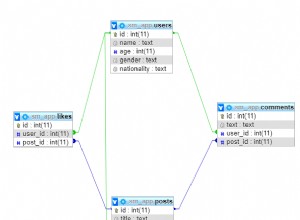Witamy w trzecim rozdziale serii poświęconej infrastrukturze chmury Oracle i terraformie, jeśli przegapiłeś poprzednie rozdziały, tutaj możesz znaleźć linki:
- Skonfiguruj dostawcę Terraform Oracle Cloud.
- Wdróż instancję obliczeniową Oracle Cloud za pomocą terraform
Po pomyślnym uruchomieniu naszej pierwszej instancji jesteśmy teraz gotowi na bardziej skomplikowany przykład.
Konfiguracja środowiska
W naszym repozytorium zmień katalog i wejdź do katalogu instancji-pool:
cd oracle-cloud-terraform-examples/instance-pool/
Zmodyfikuj plik vars.tf w taki sam sposób, w jaki zmodyfikowano plik vars.tf w prostym przykładzie (aby skonfigurować plik vars.tf od podstaw, postępuj zgodnie z sekcją Konfiguracja zmiennych)
Dodatkowe zmienne
W tym przykładzie mamy kilka dodatkowych zmiennych:
| Zmienna | Domyślne | Opis |
|---|---|---|
fault_domains | "FAULT-DOMAIN-1", "FAULT-DOMAIN-2", "FAULT-DOMAIN-3" | Ta zmienna to lista domen błędów, w których nasza pula instancji wdroży nasze instancje |
instance_pool_size | 2 | Liczba instancji do uruchomienia w puli instancji |
Omówienie infrastruktury
Infrastruktura jest taka sama jak w przykładzie prostej instancji, ale mamy również:
- jeden system równoważenia obciążenia sieciowego, który przekieruje ruch z Internetu do naszych instancji puli instancji
- jedna konfiguracja instancji używana przez pulę instancji
- jedna pula instancji
- dwie instancje obliczeniowe Oracle uruchomione przez pulę instancji
System równoważenia obciążenia sieciowego jest wykonywany przez:
- jeden słuchacz (port 80)
- jeden zestaw z podkładem
- po jednej kopii dla każdej instancji w puli instancji
Notatki
Kilka ważnych uwag:
- Domyślnie zapora w instancjach obliczeniowych jest wyłączona. W niektórych testach zapora spowodowała pewne problemy
- Nginx zostanie zainstalowany domyślnie (nginx jest używany do testowania reguł listy zabezpieczeń oraz do testowania konfiguracji systemu równoważenia obciążenia sieciowego)
- Używany system operacyjny to Ubuntu 20.04
Wdróż
Teraz utwórz plik terraform.tfvars (sekcja konfiguracji Terraform) i zainicjuj terraform:
terraform init
Initializing the backend...
Initializing provider plugins...
- Finding latest version of hashicorp/oci...
- Installing hashicorp/oci v4.50.0...
- Installed hashicorp/oci v4.50.0 (signed by HashiCorp)
Terraform has created a lock file .terraform.lock.hcl to record the provider
selections it made above. Include this file in your version control repository
so that Terraform can guarantee to make the same selections by default when
you run "terraform init" in the future.
Terraform has been successfully initialized!
You may now begin working with Terraform. Try running "terraform plan" to see
any changes that are required for your infrastructure. All Terraform commands
should now work.
If you ever set or change modules or backend configuration for Terraform,
rerun this command to reinitialize your working directory. If you forget, other
commands will detect it and remind you to do so if necessary.
jesteśmy już gotowi do wdrożenia naszej infrastruktury:
terraform plan
Terraform used the selected providers to generate the following execution plan. Resource actions are indicated with the following symbols:
+ create
Terraform will perform the following actions:
# oci_core_default_route_table.default_oci_core_default_route_table will be created
+ resource "oci_core_default_route_table" "default_oci_core_default_route_table" {
+ compartment_id = (known after apply)
+ defined_tags = (known after apply)
+ display_name = (known after apply)
+ freeform_tags = (known after apply)
+ id = (known after apply)
+ manage_default_resource_id = (known after apply)
+ state = (known after apply)
+ time_created = (known after apply)
+ route_rules {
+ cidr_block = (known after apply)
+ description = (known after apply)
+ destination = "0.0.0.0/0"
+ destination_type = "CIDR_BLOCK"
+ network_entity_id = (known after apply)
}
}
<TRUNCATED OUTPUT>
Plan: 14 to add, 0 to change, 0 to destroy.
Changes to Outputs:
+ instances_ips = [
+ (known after apply),
+ (known after apply),
]
+ lb_ip = (known after apply)
──────────────────────────────────────────────────────────────────────────────────────────────────────────────────────────────────────────────────────────────────────────────────────────────────────────────────────
Note: You didn't use the -out option to save this plan, so Terraform can't guarantee to take exactly these actions if you run "terraform apply" now.
jeśli nie mamy błędu uruchom:
terraform apply
Terraform used the selected providers to generate the following execution plan. Resource actions are indicated with the following symbols:
+ create
<= read (data resources)
Terraform will perform the following actions:
# data.oci_core_instance.ubuntu_instance_pool_instances_ips[0] will be read during apply
# (config refers to values not yet known)
<= data "oci_core_instance" "ubuntu_instance_pool_instances_ips" {
+ agent_config = (known after apply)
+ async = (known after apply)
+ availability_config = (known after apply)
+ availability_domain = (known after apply)
+ boot_volume_id = (known after apply)
+ capacity_reservation_id = (known after apply)
+ compartment_id = (known after apply)
+ create_vnic_details = (known after apply)
+ dedicated_vm_host_id = (known after apply)
+ defined_tags = (known after apply)
+ display_name = (known after apply)
+ extended_metadata = (known after apply)
+ fault_domain = (known after apply)
+ freeform_tags = (known after apply)
+ hostname_label = (known after apply)
+ id = (known after apply)
+ image = (known after apply)
+ instance_id = (known after apply)
+ instance_options = (known after apply)
+ ipxe_script = (known after apply)
+ is_pv_encryption_in_transit_enabled = (known after apply)
+ launch_mode = (known after apply)
+ launch_options = (known after apply)
+ metadata = (known after apply)
+ platform_config = (known after apply)
+ preemptible_instance_config = (known after apply)
+ preserve_boot_volume = (known after apply)
+ private_ip = (known after apply)
+ public_ip = (known after apply)
+ region = (known after apply)
+ shape = (known after apply)
+ shape_config = (known after apply)
+ source_details = (known after apply)
+ state = (known after apply)
+ subnet_id = (known after apply)
+ system_tags = (known after apply)
+ time_created = (known after apply)
+ time_maintenance_reboot_due = (known after apply)
}
<TRUNCATED OUTPUT>
oci_network_load_balancer_listener.test_listener: Creation complete after 25s [id=networkLoadBalancers/ocid1.networkloadbalancer.oc1.eu-zurich-1.amaaaaaa5kjm7pyarkfapfnqqxrwaowlnmj5mnd3etmig5nfcwd3m5yb7uha/listeners/LB%20test%20listener]
oci_network_load_balancer_backend.test_backend[1]: Still creating... [31s elapsed]
oci_network_load_balancer_backend.test_backend[0]: Still creating... [31s elapsed]
oci_network_load_balancer_backend.test_backend[0]: Still creating... [41s elapsed]
oci_network_load_balancer_backend.test_backend[1]: Still creating... [41s elapsed]
oci_network_load_balancer_backend.test_backend[0]: Creation complete after 42s [id=networkLoadBalancers/ocid1.networkloadbalancer.oc1.eu-zurich-1.amaaaaaa5kjm7pyarkfapfnqqxrwaowlnmj5mnd3etmig5nfcwd3m5yb7uha/backendSets/Backend%20set%20test/backends/ocid1.instance.oc1.eu-zurich-1.an5heljr5kjm7pycu5exolhnubsq5isqo6nveddlmlsblkz7geb6vbwsvbtq.80]
oci_network_load_balancer_backend.test_backend[1]: Still creating... [51s elapsed]
oci_network_load_balancer_backend.test_backend[1]: Still creating... [1m1s elapsed]
oci_network_load_balancer_backend.test_backend[1]: Still creating... [1m11s elapsed]
oci_network_load_balancer_backend.test_backend[1]: Creation complete after 1m14s [id=networkLoadBalancers/ocid1.networkloadbalancer.oc1.eu-zurich-1.amaaaaaa5kjm7pyarkfapfnqqxrwaowlnmj5mnd3etmig5nfcwd3m5yb7uha/backendSets/Backend%20set%20test/backends/ocid1.instance.oc1.eu-zurich-1.an5heljr5kjm7pycft5ixge6ssknpyb5s6q3eihuccogpqrvv2ntqdlww72a.80]
Apply complete! Resources: 14 added, 0 changed, 0 destroyed.
Outputs:
instances_ips = [
"132.x.x.x",
"152.x.x.x",
]
lb_ip = tolist([
{
"ip_address" = "140.x.x.x"
"is_public" = true
"reserved_ip" = tolist([])
},
])
Teraz możemy ssh w jednej z wdrożonych instancji:
ssh [email protected]
...
35 updates can be applied immediately.
25 of these updates are standard security updates.
To see these additional updates run: apt list --upgradable
The programs included with the Ubuntu system are free software;
the exact distribution terms for each program are described in the
individual files in /usr/share/doc/*/copyright.
Ubuntu comes with ABSOLUTELY NO WARRANTY, to the extent permitted by
applicable law.
To run a command as administrator (user "root"), use "sudo <command>".
See "man sudo_root" for details.
ubuntu@inst-ikudx-ubuntu-instance-pool:~$
Po kilku minutach (co najmniej jeden backend musi być w stanie HEALTH) również system równoważenia obciążenia sieci odpowie na nasze żądania:
curl -v 140.x.x.x
* Trying 140.x.x.x:80...
* TCP_NODELAY set
* Connected to 140.x.x.x (140.x.x.x) port 80 (#0)
> GET / HTTP/1.1
> Host: 140.x.x.x
> User-Agent: curl/7.68.0
> Accept: */*
>
* Mark bundle as not supporting multiuse
< HTTP/1.1 200 OK
< Server: nginx/1.18.0 (Ubuntu)
< Date: Wed, 27 Oct 2021 15:39:51 GMT
< Content-Type: text/html
< Content-Length: 672
< Last-Modified: Wed, 27 Oct 2021 15:33:26 GMT
< Connection: keep-alive
< ETag: "61797146-2a0"
< Accept-Ranges: bytes
...
...
...
Oczyszczanie
Aby posprzątać/zniszczyć naszą infrastrukturę:
terraform destroy




